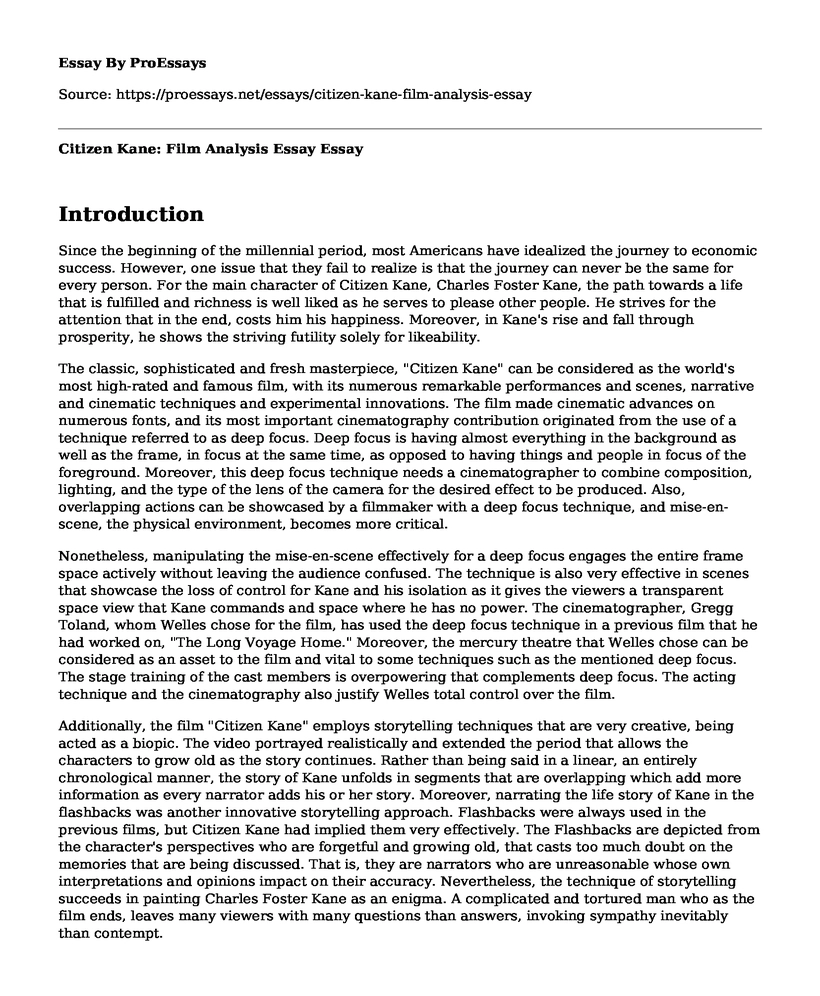Introduction
Since the beginning of the millennial period, most Americans have idealized the journey to economic success. However, one issue that they fail to realize is that the journey can never be the same for every person. For the main character of Citizen Kane, Charles Foster Kane, the path towards a life that is fulfilled and richness is well liked as he serves to please other people. He strives for the attention that in the end, costs him his happiness. Moreover, in Kane's rise and fall through prosperity, he shows the striving futility solely for likeability.
The classic, sophisticated and fresh masterpiece, "Citizen Kane" can be considered as the world's most high-rated and famous film, with its numerous remarkable performances and scenes, narrative and cinematic techniques and experimental innovations. The film made cinematic advances on numerous fonts, and its most important cinematography contribution originated from the use of a technique referred to as deep focus. Deep focus is having almost everything in the background as well as the frame, in focus at the same time, as opposed to having things and people in focus of the foreground. Moreover, this deep focus technique needs a cinematographer to combine composition, lighting, and the type of the lens of the camera for the desired effect to be produced. Also, overlapping actions can be showcased by a filmmaker with a deep focus technique, and mise-en-scene, the physical environment, becomes more critical.
Nonetheless, manipulating the mise-en-scene effectively for a deep focus engages the entire frame space actively without leaving the audience confused. The technique is also very effective in scenes that showcase the loss of control for Kane and his isolation as it gives the viewers a transparent space view that Kane commands and space where he has no power. The cinematographer, Gregg Toland, whom Welles chose for the film, has used the deep focus technique in a previous film that he had worked on, "The Long Voyage Home." Moreover, the mercury theatre that Welles chose can be considered as an asset to the film and vital to some techniques such as the mentioned deep focus. The stage training of the cast members is overpowering that complements deep focus. The acting technique and the cinematography also justify Welles total control over the film.
Additionally, the film "Citizen Kane" employs storytelling techniques that are very creative, being acted as a biopic. The video portrayed realistically and extended the period that allows the characters to grow old as the story continues. Rather than being said in a linear, an entirely chronological manner, the story of Kane unfolds in segments that are overlapping which add more information as every narrator adds his or her story. Moreover, narrating the life story of Kane in the flashbacks was another innovative storytelling approach. Flashbacks were always used in the previous films, but Citizen Kane had implied them very effectively. The Flashbacks are depicted from the character's perspectives who are forgetful and growing old, that casts too much doubt on the memories that are being discussed. That is, they are narrators who are unreasonable whose own interpretations and opinions impact on their accuracy. Nevertheless, the technique of storytelling succeeds in painting Charles Foster Kane as an enigma. A complicated and tortured man who as the film ends, leaves many viewers with many questions than answers, invoking sympathy inevitably than contempt.
The achievements of Welles in Citizen Kane marked a new direction towards cinema. Numerous critics argue that the film, with its inventive use of shadow and lighting, is the first noir film, a genre that showcases a moody atmosphere and dark environment to augment the often mysterious or violent events that are taking place. Moreover, the film introduced Hollywood to the cinema technique creative potential.
Nonetheless, along with Kane's personal story is the period history. The film covers the expansion and rise of the penny press, the birth of radio, the rise of fascism, the Spanish-American war that is Hearst-supported, the rise of journalism celebrity and the power of political machines. The screenplay that Welles used is constructed densely, covering the fantastic amount of ground. Citizen Kane as the main character knows that the sled can never be the answer. It explains the Rosebud but does not reveal its meaning. This construction of the film depicts how the lives of people after they have died, survive only in other people's memories, and those memories at some point, butt up against the roles we play in our lives and walls that we erect. This scenario is depicted in the parts where Kane made figures of shadow using his fingers, hated the trust of traction, millions were entertained by him and later, died alone.
Bravura visual moments are also filled in the movie and sections such as the towers of Xanadu, the swooping camera via a skylight to the pathetic Susan in a club, to mention, but a few are depicted. The great camera shot rises straight from the opera debut of Susan to a stagehand while holding the nose, Kane's face hidden in a shadow makes the audience curious of what might be next, leaving them in suspense, that makes the film more capturing.
Cite this page
Citizen Kane: Film Analysis Essay. (2022, Nov 01). Retrieved from https://proessays.net/essays/citizen-kane-film-analysis-essay
If you are the original author of this essay and no longer wish to have it published on the ProEssays website, please click below to request its removal:
- Discharged for Off-Duty Behavior Paper Example
- What Makes Argentine Dance Special
- Movie Analysis Essay on Moonlight
- Essay Example on Patch Adams: Inspiring True Story of Healing With Humor
- Fast Fashion: Idol of Youth or Environmental Hazard? - Essay Sample
- Essay Example on Music: An Expression of Ideas & Emotions Through Time
- Australia vs Singapore: Consumer Behavior at the Princess Theatre - Essay Sample







